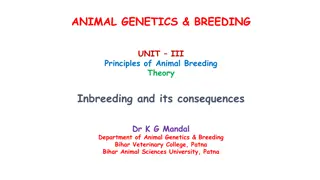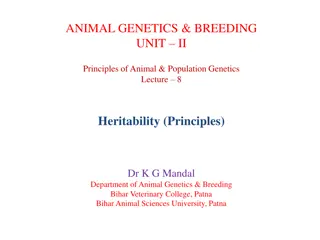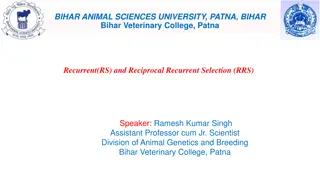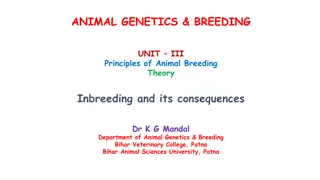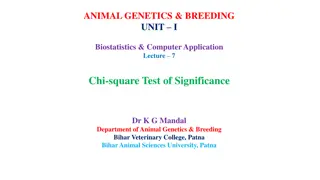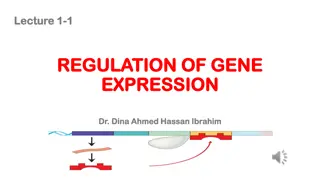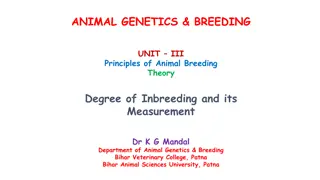Understanding Average Gene Effect and Breeding Value in Animal Genetics
In the field of animal genetics and breeding, it is crucial to comprehend the average effect of genes and breeding value of individuals. Genes are transmitted from parents to offspring through haploid gametes, influencing the genotype and breeding potential. Estimating the average effect of a gene involves considering genotypic values and frequencies of alleles. This process plays a significant role in determining the genetic properties of populations and the value passed on from generation to generation.
Download Presentation

Please find below an Image/Link to download the presentation.
The content on the website is provided AS IS for your information and personal use only. It may not be sold, licensed, or shared on other websites without obtaining consent from the author. Download presentation by click this link. If you encounter any issues during the download, it is possible that the publisher has removed the file from their server.
E N D
Presentation Transcript
ANIMAL GENETICS & BREEDING UNIT II Principles of Animal & Population Genetics Lecture 6 Average Effect of Gene & Breeding Value Dr K G Mandal Department of Animal Genetics & Breeding Bihar Veterinary College, Patna Bihar Animal Sciences University, Patna
Introduction There is relationship between genetic properties of a population and transmission of value from parents to offspring. Genotype is not transmitted from parents to offspring as such, it is the genes which are being transmitted from parents to offspring through haploid gametes. These genes combine together to form the new genotype of the progeny and they act additively or non- additively. Therefore, it is imperative to measure the average effect of genes which are transmitted from parents to offspring and thereby the breeding value of the individual which is carrying those genes.
Average effect of Gene The average effect of a gene will enable us to determine the breeding value of an individual. Breeding value is the value associated with the genes carried by an individual and transmitted to the offspring. The average effect of a gene is the mean deviation from the population mean of individuals which have received that gene from one parent and the gene received from other parent having come at random from the population. Let a number of gametes all carrying A1 gene united at random with gametes carrying either A1 or A2 gene from a random breeding population, then the mean deviation of the genotypes so produced from the population mean will be referred as the average effect of the gene A1.
Estimation of average effect of a gene Let us see how the average effect of a gene is related to the genotypic values a and d, in terms of which the population mean was expressed. Let us consider a locus with two alleles A1 & A2 with their respective frequencies as p and q. Let us consider the average effect of A1 gene is 1 and to that of A2 is 2.
Gene A1 A2 _______________________________________________________ A1= A1A1 A1 Gene A2= A1A2 Genotype Frequency Genotypic Value A1A1 p A1A2 q _________________________________________ Frequency p q Average effect 1 2 a d ap qd
Let the gametes carrying A1 gene united at random with the gametes carrying either A1 or A2 gene taken from a random mating population, then the frequencies of A1A1 and A1A2 genotypes will be p and q respectively, since the frequencies of A1 and A2 genes in the whole gametic population are p and q respectively. The assigned genotypic value of A1A1 is +a and to that of A1A2 is d. Thus the genotypic value of A1A1 and A1A2 is ap and qd respectively. Thus, the mean genotypic value of A1A1 and A1A2 genotypes is (ap + qd)/ (p + q).= ap + qd.
The difference between the mean of these two genotypes so produced from the population mean is the average effect of the gene A1. Thus, the average effect of the gene A1 is, 1 = (ap + qd) [a(p q) + 2pqd] = ap + qd ap + aq -2pqd = aq + qd 2pqd = q[a + d - 2pd ] = q[a + d(1 2p)] = q[a + d (p + q 2p)] = q[a + d(q p)]
Gene A1 A2 _______________________________________________________ A1= A1A2 A2 Gene A2= A2A2 GenotypeFrequency Assigned Value A1A2 p A2A2 q _________________________________________ Frequency p q Average effect 1 2 GV pd - aq d - a
Let the gametes carrying A2 gene united at random with the gametes carrying either A1 or A2 gene taken from a random mating population, then the frequencies of A1A2 and A2A2 genotypes will be p and q respectively, since the frequencies of A1 and A2 genes in the whole gametic population are p and q respectively. The assigned genotypic value of A1A2 is d and to that of A2A2 is - a. Thus the genotypic value of A1A2 and A2A2 is pd and - aq respectively. Thus, the mean genotypic value of A1A2 and A2A2 genotypes is (pd - aq)/ (p + q).= pd aq.
Thus, the average effect of gene A2, 2 = pd - aq -[a(p-q)+2pqd] = pd- aq ap +aq - 2pqd = p[-a+d-2qd] = p[-a + d(1 2q)] = -p[a-d(p+q-2q)] = - p[a d(p q)] = -p[a+d(q-p)] Thus, 1= q[a+d(q-p)] 2 = - p[a+d(q-p)]
Average effect of gene in terms of gene substitution The average effect of a gene substitution is the difference between the average effect of two genes in question for a given locus. Suppose A2 gene is substituted or changed by A1, then A1A2 will be changed into A1A1, and A2A2 will be changed into A1A2. Changing from A1A2 to A1A1 there will be change of the genotypic value from d to a, and the effect will be (a d). And changing from A2A2 to A1A2 there will be change of genotypic value from a to d. Therefore, the effect will be {d (-a)} = (d + a).
Since A2 gene is taken at random from the population, a proportion of A2 will be found in A1A2, the frequency of which is equal to p, and a proportion of the same gene i.e.,A2 will be found in A2A2 which is equal to q. Thus, due to change from A1A2 to A1A1, the genotypic value of A1A1 will be p(a d) and due to change from A2A2 to A1A2, the genotypic value A1A2 will be q(d + a).
The average change is, therefore, This is the average effect of gene substitution. [p(a d) + q(d + a)] = [pa pd + qd + aq] = [pa + aq + qd pd] = a(p + q) + d(q p) = a + d( q p) =
Relation between , 1 and 2 can be seen from the following equation: 1 2 = q[a + d(q p)] [ - p{a + d(q p)}] = q[a + d(q p)] +p[a + d(q p)] = (q + p)[a + d(q p)] = a + d(q p) = 2 = - p[a+d(q-p)] = - p 1= q[a+d(q-p)] = q
Breeding Value Parents pass on their genes and not their genotypes to the progeny. It is, therefore, the average effect of the parent s genes that determine the mean genotypic value of the progeny. The value of an individual is judged by the mean value of its progeny, which is called the breeding value of the individual. Thus Breeding value of an individual is the mean phenotypic value of its progeny.
If an individual is mated to a number of individuals taken at random from the population, then its breeding value is twice the mean deviation of the progeny from the population mean. The deviation has to be doubled because the parent in question provides only half of the genes of the progeny, the other half is coming at random from the population. Breeding values can be expressed in absolute units but more conveniently expressed as deviation from the population mean. Breeding value is also defined as the value associated with the genes carried by an individual.
In terms of average effect of gene, the breeding value of an individual is equal to sum of the average effect of genes it carries, the summation being made over the pair of alleles at each locus and over all loci. Estimation of Breeding Value For a single locus with two alleles A1 & A2, the breeding values of three genotypes will be as follows: Genotype Breeding value Breeding Value A1A1 A1A2 A2A2 2 1 1+ 2 2 2 2q (q-p) - 2p
Mean Breeding Value If breeding values are expressed in absolute units the mean breeding value must be equal to the mean genotypic value and to the mean phenotypic value. In a Hardy Weinberg Equilibrium population the mean breeding value is equal to zero. This can be verified by multiplying the breeding value by the frequency of each genotype and their summation gives the mean breeding value.
Thus, mean breeding value, expressed as deviation from the population mean, as : Genotype Frequency Breeding value Freq x Breeding value A1A1 P2 2q P2(2q ) A1A2 2pq (q p) 2pq(q p) A2A2 q2 - 2p q2(-2p ) 2p2q + 2pq(q p) 2q2p = 2pq [p + q p q] = 0
The breeding value is also known as additive effect of gene and is denoted by A. In absence of dominance effect, the breeding value is equivalent to genotypic value. Thus, G = A
Dominance Deviation Dominance deviation is the interaction between alleles within a locus. It is also known as intra genic gene interaction. When a single locus is under consideration, the difference between the genotypic value G and the breeding value A of a particular genotype is known as dominance deviation. So that, G = A + D. Since the average effect of genes and the breeding values of genotypes are dependent on gene frequency in the population, the dominance deviation is also dependent on gene frequency.
The dominance deviation can be expressed in terms of arbitrary assigned genotypic values a and d by subtraction of breeding value from the genotypic value. Considering a single locus with two alleles A1 and A2 with respective frequency p and q, the dominance deviation of three genotypes will be as follows: Genotype Frequency Assigned Value Breeding Value Dominance Deviation A1A1 P2 a 2q - 2q2d A1A2 2pq d (q p) 2pqd A2A2 q2 - a - 2p - 2p2d
Mean Dominance Deviation Since dominance deviations are expressed as deviation from the population mean, therefore, the mean dominance deviation will be equal zero. This can be verified by multiplying the dominance deviation with frequency of respective genotype and summing over all the genotypes. Thus, the mean dominance deviation is - 2p2q2d + 4p2q2d 2p2q2d = 0 All the dominance deviations are the function of d, if d is zero then dominance deviation will also be zero. Therefore, in absence of dominance deviation the breeding values and dominance deviations will be the same.
Interaction Deviation When a single locus is under consideration, the genotypic value is made up of breeding value and dominance deviation only. When two or more than two loci are involved for the expression of a character, then the genotypic value may contain an additional deviation due to non-additive gene combination. Let GA be the genotypic value of an individual attributable to a locus A and GB attributable to another locus B, then the aggregate genotypic value of both the loci together G = GA + GB + IAB, Where, IAB is the interaction deviation , deviated from additive combination of these genotypic values. This IAB is also known as gene interaction or epistasis.
Therefore, for polygenic traits when several loci interacted together for expression of a trait then, genotypic value can be written as G = A + D + I Where , A = sum of the breeding values attributable to several loci. D = Sum of the dominance deviations I = Sum of the Interaction deviations The mean interaction deviations of all the loci in a population is equal to zero.




